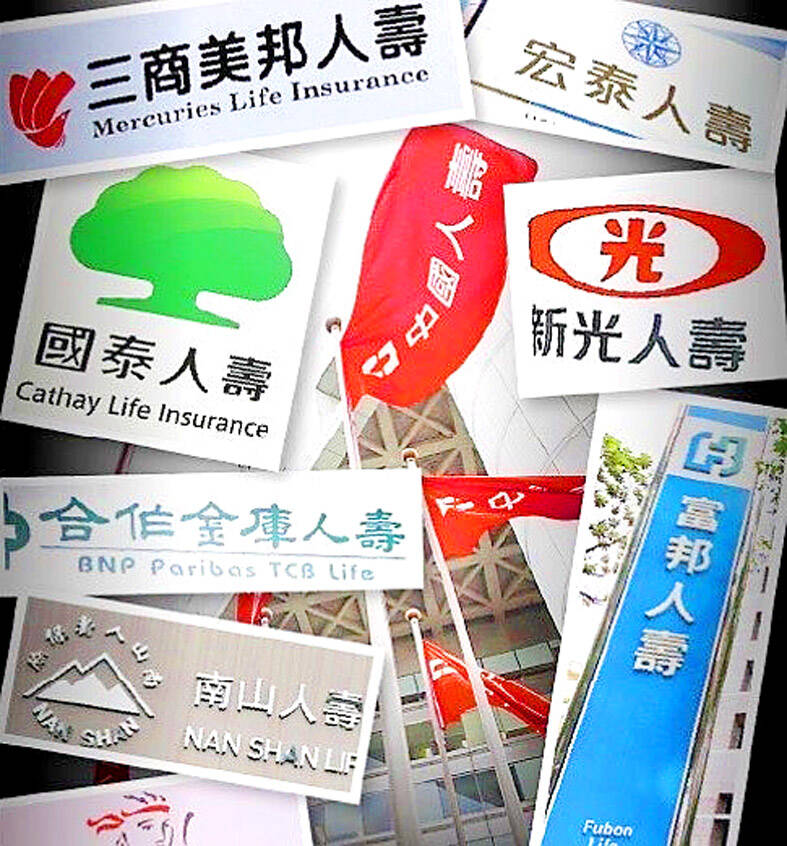Taiwan’s insurance industry is likely to see their assets grow next year amid a stable economy at home and continued normalization of monetary policy abroad, KPMG Taiwan said in an annual report released yesterday.
The sector’s collective profit exceeded NT$300 billion (US$9.24 billion) in the first eight months, already higher than the whole of last year, the consultancy firm said, citing data from the Financial Supervisory Commission.
The improvement came after global economic conditions and financial markets turn favorable this year, compared with last year, KPMG analyst Joyce Tsai (蔡珮汝) said, as major central banks cut interest rates after inflationary pressures mitigated.

Photo: Taipei Times
Monetary tightening hurt the value of bond holdings and prompted corporate and retail investors to hold onto cash, ominous for sales of insurance policy and wealth management as a whole.
The economic scenes look stable moving forward, as the US Federal Reserve would further lower interest rates like peers in Europe and elsewhere, in the absence of major surprises, KPMG said.
The backdrop is positive for the sector to augment its assets, which picked up 3.8 percent last year to NT$35.38 trillion, it said.
The volume accounted for 33.72 percent of the assets for the entire financial industry, slowing from 34.17 percent one year earlier, as insurers have not fully emerged from global monetary tightening and structural changes.
Taiwan notched 14th last year in premium rankings, down from 11th place one year earlier, with its market share falling from 1.28 percent to 1.09 percent on the world stage, the report pointed out.
At the same time, insurance penetration dropped from 11.4 percent to 10.3 percent of the nation’s GDP, sliding from fifth to sixth globally and behind Hong Kong and South Korea in the region, it said.
Taiwan retained the world’s leading position for 13 years by measure of insurance penetration until 2020 when low interest rates and regulatory restrictions regarding bond holdings dampened the appeal of unit-linked insurance policies, formerly a popular investment tool among Taiwanese, analysts said.
Taiwan’s super-aging society poses a challenge and presents an opportunity for insurance players, another KPMG analyst Michael Lien (連宏銘) said.
The world population is aging, but the phenomenon is more poignant in Taiwan where the proportion of people aged 65 and older is expected to hit 20 percent next year, Lien said.
The demographic trend is unfavorable for doing business generally but suggests need for life planning and risk management, Lien said.
The insurance industry could develop financial products to help people cope with the evident and inevitable needs, Lien said.

Intel Corp chief executive officer Lip-Bu Tan (陳立武) is expected to meet with Taiwanese suppliers next month in conjunction with the opening of the Computex Taipei trade show, supply chain sources said on Monday. The visit, the first for Tan to Taiwan since assuming his new post last month, would be aimed at enhancing Intel’s ties with suppliers in Taiwan as he attempts to help turn around the struggling US chipmaker, the sources said. Tan is to hold a banquet to celebrate Intel’s 40-year presence in Taiwan before Computex opens on May 20 and invite dozens of Taiwanese suppliers to exchange views

Application-specific integrated circuit designer Faraday Technology Corp (智原) yesterday said that although revenue this quarter would decline 30 percent from last quarter, it retained its full-year forecast of revenue growth of 100 percent. The company attributed the quarterly drop to a slowdown in customers’ production of chips using Faraday’s advanced packaging technology. The company is still confident about its revenue growth this year, given its strong “design-win” — or the projects it won to help customers design their chips, Faraday president Steve Wang (王國雍) told an online earnings conference. “The design-win this year is better than we expected. We believe we will win

Chizuko Kimura has become the first female sushi chef in the world to win a Michelin star, fulfilling a promise she made to her dying husband to continue his legacy. The 54-year-old Japanese chef regained the Michelin star her late husband, Shunei Kimura, won three years ago for their Sushi Shunei restaurant in Paris. For Shunei Kimura, the star was a dream come true. However, the joy was short-lived. He died from cancer just three months later in June 2022. He was 65. The following year, the restaurant in the heart of Montmartre lost its star rating. Chizuko Kimura insisted that the new star is still down

While China’s leaders use their economic and political might to fight US President Donald Trump’s trade war “to the end,” its army of social media soldiers are embarking on a more humorous campaign online. Trump’s tariff blitz has seen Washington and Beijing impose eye-watering duties on imports from the other, fanning a standoff between the economic superpowers that has sparked global recession fears and sent markets into a tailspin. Trump says his policy is a response to years of being “ripped off” by other countries and aims to bring manufacturing to the US, forcing companies to employ US workers. However, China’s online warriors